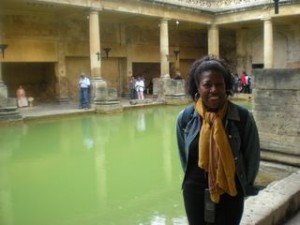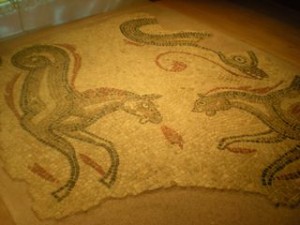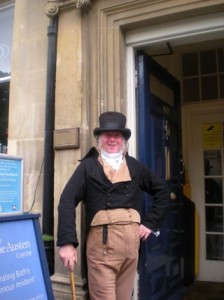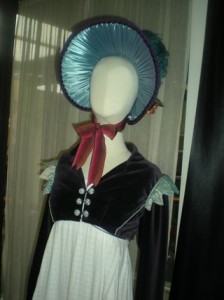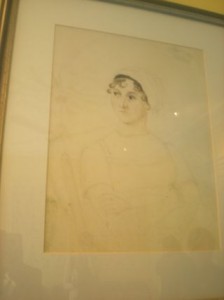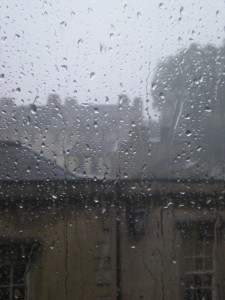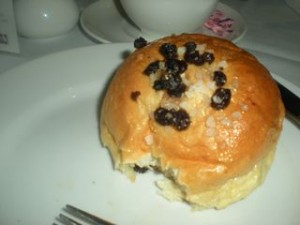I think I was a Roman noble woman in a past life. I am certain that I frequented the Roman baths at Bath, known as Aquae Sulis, in that former life. It would explain why I like spas so much. I would have started in the hot spring waters, about 114 F, of the Great Bath, relaxing in one of its alcoves after my swim and maybe purchasing the latest Egyptian fragrance from one of the roaming vendors. I’d probably move to one of the steam rooms in the West Bath and take a cooling dip in the natural spring waters of the frigidarium, a wonderful cleansing treatment for my pores. It’s hard not to get immersed in the rich history presented at the Roman ruins of Bath, the original health spa. It clearly deserves its status as a World Hertitage Site from UNESCO. The two-hour long audio tour is an expert bit of storytelling, laying out the historical, cultural, archeological and architectural significance of the place in a very accessible way. It is truly stunning to see how well preserved the ruins are from the baths to a temple worshipping the wise goddess Sulis-Minerva. I loved learning about how the Romans of Aquae Sulis turned to Sulis-Minerva to dole out punishment to people who had wronged them, hiring professional curse-writers to put their offenses to paper or pewter and tossing them into her sacred springs for her consideration. A perfectly-preserved bronze head from a statue of the goddess at the temple is the crowned jewel of the entire site. While wandering through the relatively manageable crowds, I was was struck by a small group of students who looked to be no more than 6, cradling audio phones almost half the size of their bodies to their ears and scribbling notes on the ruins on clipboards. At the end of the tour, you are invited to sample the spring’s restorative waters, which I do. If you like your water warm with the taste of a copper penny, you’ll enjoy it. The water was definitely minerally and you can imagine the infirmed “taking the water” like taking Phillips Milk of Magnesia. Not tasty, but something you have to do in the hopes of feeling better.
 The water tasting takes place in the “Pump Room,” a dining space built on top of the temple ruins that harkens back to the 18th century history of Bath. A piano player plays a delightful tune and I decide to have lunch and imagine couples waltzing beneath a golden chandelier. I am starved after the two-hour tour and order a roast beef sandwich with tomato soup and fries along with a ginger beer. I relish the fact that I’ve missed another one of Brittain’s unexpected cloud bursts as I lunch. I don’t have much time to linger because I want to visit the Jane Austen Center about a 10-minute walk away. A top-hatted, white-haired gentleman greets me as I enter the center to explore more about another one of my favorite authors. Jane Austen lived in Bath in a house similar the one that the center is housed in a few doors down. The city is featured prominently in her first and last novels “Northhanger Abbey” and “Persuasion.” If you are a fan of Austen, you’ll appreciate this thoughtful, but small exhibit placing her life and work in context in Bath. I studied a copy of a portait of Jane as drawn by her sister and a letter written in her own hand. The Regency Tea Room sits on the top floor of the Jane Austen Center and this would be a perfect place for afternoon tea. I order the Jane Austen Blend of loose teas and the Bath bun, a sweet yeasty bun dotted with raisins. Once again, I marvel at my luck dodging a particularly fierce rain storm with lighting shooting from blackened clouds. I am cozy in a room full of portraits of Austen and Mr. Darcy; harpsicord music plays in the background. I’ve gone from feeling Roman to positively British.
The water tasting takes place in the “Pump Room,” a dining space built on top of the temple ruins that harkens back to the 18th century history of Bath. A piano player plays a delightful tune and I decide to have lunch and imagine couples waltzing beneath a golden chandelier. I am starved after the two-hour tour and order a roast beef sandwich with tomato soup and fries along with a ginger beer. I relish the fact that I’ve missed another one of Brittain’s unexpected cloud bursts as I lunch. I don’t have much time to linger because I want to visit the Jane Austen Center about a 10-minute walk away. A top-hatted, white-haired gentleman greets me as I enter the center to explore more about another one of my favorite authors. Jane Austen lived in Bath in a house similar the one that the center is housed in a few doors down. The city is featured prominently in her first and last novels “Northhanger Abbey” and “Persuasion.” If you are a fan of Austen, you’ll appreciate this thoughtful, but small exhibit placing her life and work in context in Bath. I studied a copy of a portait of Jane as drawn by her sister and a letter written in her own hand. The Regency Tea Room sits on the top floor of the Jane Austen Center and this would be a perfect place for afternoon tea. I order the Jane Austen Blend of loose teas and the Bath bun, a sweet yeasty bun dotted with raisins. Once again, I marvel at my luck dodging a particularly fierce rain storm with lighting shooting from blackened clouds. I am cozy in a room full of portraits of Austen and Mr. Darcy; harpsicord music plays in the background. I’ve gone from feeling Roman to positively British.
